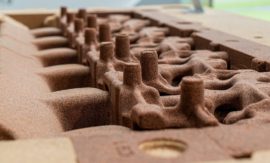Intended learning outcomes: Explain how discontinuity or lumpiness of the demand influences the sum of carrying costs and setup and ordering costs, comparing the MRP technique with the order point technique.
This scenario refers to Section 11.3 and to Section 12.3. Section 11.3 presents the ROP (Re)-order point technique, including the safety stock calculation. Section 12.3 presents the MRP technique.
It is clear why, in the comparison in Figure 6.5.2.1, the MRP is rated to be complicated with regard to the order point technique or the Kanban technique. Section 12.3.1 explained why discontinuous demand is a main reason for the need of the MRP technique for determining stochastic dependent demand (or quasideterministic demand). We created an example that will give you a sense of how discontinuity or lumpiness of the demand influences the sum of carrying costs and setup and ordering costs, comparing the MRP technique with the order point technique. You can view the animation at the following URL:
Note that to compare the two techniques a safety stock of the same size as for the order point technique has been introduced for the MRP technique. It is correct to do so, because in the quasi-deterministic case, a safety demand has to be introduced for the independent demand at the end product level (see Section 10.5.5). Through the MRP algorithm, this safety demand is — in fact — always present at some stage on the value chain, just as the safety stock is present in the order point technique for a specific component. Therefore, for comparison of the two techniques, we can assume the safety demand on the component — like a safety stock.
Now, find out how the shape of the of the inventory curve according to the two techniques changes for continuous and less continuous demand (running your cursor over the gray icon shape bar will execute your input choice).
Try out different parameters to calculate the lot size or choose a different initial inventory or service level. Running the cursor over the gray icon either leads you to a specific window where you can enter your input data or executes your input choice.
The “costs” icon opens a window with the carrying costs as well as the setup and ordering costs for the two techniques. Discuss whether for the given demand pattern with less continuous demand there is sufficient reason to prefer the MRP technique. Consider that the calculated costs do not take into account either the batch-size-dependent unit costs — which is the same for both techniques, but generally by far higher than the sum of carrying, setup, and ordering costs — or the administration costs for the implementation and use of the specific materials management technique.
Try out other demand values. Observe the effect of issue quantities on the order of the production or procurement batch size. Again, use the “calculate” icon to execute your input choice. The initial demand values are automatically re-entered by touching the gray demand icon. Note what happens with the curves as you continue to enter sequences of two or more periods with zero demand, interrupted by one or two periods with very high demand. You will see that the order point technique will not be able to handle this demand pattern. The projected available inventory level will sometimes fall below zero, engendering opportunity costs that we did even not consider in the costs comparison.
Course section 12.8: Subsections and their intended learning outcomes

12.8 Scenarios and Exercises
Intended learning outcomes: Calculate projected available inventory. Determine net requirements and planned release using the MRP technique. Differentiate between order point technique and MRP technique.

12.8.1 Exercise: Projected Available Inventory Calculation
Intended learning outcomes: Calculate projected available inventory by completing a grid.

12.8.2 Exercise on the MRP Technique: Determining Net Requirements and Planned Release
Intended learning outcomes: Determine net requirements and planned release using the MRP technique, whereupon the physical inventory and gross requirements are given.

12.8.3 Scenario: Order Point Technique versus MRP Technique
Intended learning outcomes: Explain how discontinuity or lumpiness of the demand influences the sum of carrying costs and setup and ordering costs, comparing the MRP technique with the order point technique.
